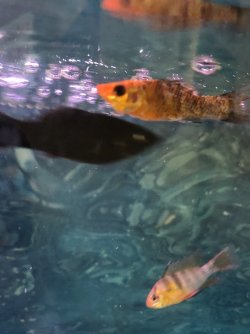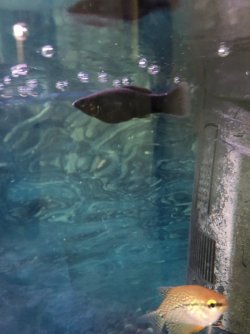In the wild, female livebearers hang out in large groups consisting of between 20 & 50 (but sometimes up to 100 or more) females. These groups have a pecking order with the biggest most dominant female ruling the group and she has a group of girlfriends who back her up. All the other females live in the group but are lower down the pecking order.
The groups of females move around rivers and waterways looking for food and places to hang out. As the groups move around a few males follow the group and try to breed with any females. The groups of males have a pecking order too and the biggest male will bully his smaller mates.
In the confines of an aquarium, the males will constantly harass the females and try to breed with them. This puts undue stress on the females and if there are too many males constantly pestering the females, the females can get sick and die.
It is preferable to keep livebearers in single sex tanks (either male or female but not both sexes together). If you want a group of males and females then have 1 male and at least 6 females (preferably 10 or more females per male).
Female livebearers can carry up to 6 sperm packets from breeding with males and they use 1 sperm packet to fertilise each batch of eggs. The gestation period (from the time she fertilises the eggs to when she gives birth to free swimming babies) is about 1 month. After which she will fertilise another batch of eggs using another sperm packet. This allows female livebearers to produce young about once a month for up to 6 months without any males being present.
If you want to breed livebearers then have a tank with females and let them give birth and use up all the sperm packets they are carrying in their body. Give them a few months without being pregnant and then add a male to the tank for a week before moving him out, or move the female/s into a tank with a male for a week and let them breed. Then move the females back into their own tank.
Your orange female was probably in charge of the tank and has been displaced by the new black female.
-------------------------
The orange female has a large red sore on the gill cover and you need to monitor this for infection. If it turns white and fluffy then it has a fungal infection. If the red area gets bigger and does not start to heal up quickly, it has a bacterial infection.
The best thing to do for injured fish is keep the tank clean and add some salt.
Do a 75% water change and gravel clean the substrate every day for 2 weeks. Make sure any new water is free of chlorine/ chloramine before it's added to the tank.
Clean the filter if it hasn't been done in the last 2 weeks. However, if the filter is less than 6 weeks old, don't clean it. When you clean the filter, wash the filter media/ materials in a bucket of tank water.
Increase aeration/ surface turbulence to maximise the oxygen levels in the water.
-------------------------
You can add rock salt (often sold as aquarium salt), sea salt or swimming pool salt to the aquarium at the dose rate of 1 heaped tablespoon per 20 litres of water. If there is no improvement after 48 hours you can double that dose rate so there is 2 heaped tablespoons of salt per 20 litres.
If you only have livebearers (guppies, platies, swordtails, mollies), goldfish or rainbowfish in the tank you can double that dose rate, so you would add 2 heaped tablespoons per 20 litres and if there is no improvement after 48 hours, then increase it so there is a total of 4 heaped tablespoons of salt per 20 litres.
Keep the salt level like this for at least 2 weeks but no longer than 4 weeks otherwise kidney damage can occur. Kidney damage is more likely to occur in fish from soft water (tetras, Corydoras, angelfish, gouramis, loaches) that are exposed to high levels of salt for an extended period of time, and is not an issue with livebearers, rainbowfish or other salt tolerant species.
The salt will not affect the beneficial filter bacteria but the higher dose rate will affect some plants. The lower dose rate will not affect plants.
After you use salt and the fish have recovered, you do a 10% water change each day for a week using only fresh water that has been dechlorinated. Then do a 20% water change each day for a week. Then you can do bigger water changes after that. This dilutes the salt out of the tank slowly so it doesn't harm the fish.
If you do water changes while using salt, you need to treat the new water with salt before adding it to the tank. This will keep the salt level stable in the tank and minimise stress on the fish.
-------------------------
The orange female also looks skinny and probably has gill flukes and intestinal worms. The salt might treat the gill flukes and if you post another picture of her in a few weeks time, we can talk about deworming them.







